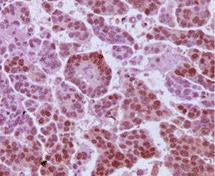| High-grade serous carcinoma | |
|---|---|
 | |
| Immunohistochemistry micrograph of androgen receptors on a HGSC tumour sample |
High-grade serous carcinoma (HGSC) is a type of tumour that arises from the serous epithelial layer in the abdominopelvic cavity and is mainly found in the ovary. HGSCs make up the majority of ovarian cancer cases[1] and have the lowest survival rates.[2] HGSC is distinct from low-grade serous carcinoma (LGSC) which arises from ovarian tissue, is less aggressive and is present in stage I ovarian cancer where tumours are localised to the ovary.
Although originally thought to arise from the squamous epithelial cell layer covering the ovary, HGSC is now thought to originate in the Fallopian tube epithelium. HGSC is much more invasive than LGSC with a higher fatality rate - although it is more sensitive to platinum-based chemotherapy,[3][4] possibly due to its rapid growth rate. In rare cases, HGSCs can develop from LGSCs,[5] but generally the two types arise independently of each other.
- ^ Shih, Ie-Ming; Kurman, Robert J. (2004-05-01). "Ovarian Tumorigenesis: A Proposed Model Based on Morphological and Molecular Genetic Analysis". The American Journal of Pathology. 164 (5): 1511–1518. doi:10.1016/S0002-9440(10)63708-X. PMC 1615664. PMID 15111296.
- ^ Olivier, R. I.; van Beurden, M.; Lubsen, M. a. C.; Rookus, M. A.; Mooij, T. M.; van de Vijver, M. J.; van't Veer, L. J. (2004-03-16). "Clinical outcome of prophylactic oophorectomy in BRCA1/BRCA2 mutation carriers and events during follow-up". British Journal of Cancer. 90 (8): 1492–1497. doi:10.1038/sj.bjc.6601692. ISSN 0007-0920. PMC 2409718. PMID 15083174.
- ^ Santillan, A.; Kim, Y.w.; Zahurak, M.l.; Gardner, G.j.; Giuntoli, R.l.; Shih, I.m.; Bristow, R.e. (2007-05-01). "Differences of chemoresistance assay between invasive micropapillary/low-grade serous ovarian carcinoma and high-grade serous ovarian carcinoma". International Journal of Gynecological Cancer. 17 (3): 601–606. doi:10.1111/j.1525-1438.2007.00820.x. ISSN 1525-1438. PMID 17504374. S2CID 21579941.
- ^ Schmeler, Kathleen M.; Sun, Charlotte C.; Bodurka, Diane C.; Deavers, Michael T.; Malpica, Anais; Coleman, Robert L.; Ramirez, Pedro T.; Gershenson, David M. (2008-03-01). "Neoadjuvant chemotherapy for low-grade serous carcinoma of the ovary or peritoneum". Gynecologic Oncology. 108 (3): 510–514. doi:10.1016/j.ygyno.2007.11.013. ISSN 1095-6859. PMID 18155273.
- ^ Dehari, Reiko; Kurman, Robert J.; Logani, Sanjay; Shih, Ie-Ming (2007-07-01). "The development of high-grade serous carcinoma from atypical proliferative (borderline) serous tumors and low-grade micropapillary serous carcinoma: a morphologic and molecular genetic analysis". The American Journal of Surgical Pathology. 31 (7): 1007–1012. doi:10.1097/PAS.0b013e31802cbbe9. ISSN 0147-5185. PMID 17592266. S2CID 37905442.